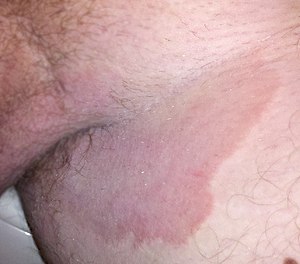Eczema marginatum
| Tinea cruris | |
|---|---|
 |
|
| Tinea cruris on the groin of a man | |
| Classification and external resources | |
| Specialty | Dermatology |
| ICD-10 | B35.6 |
| ICD-9-CM | 110.3 |
| DiseasesDB | 29140 |
| MedlinePlus | 000876 |
| eMedicine | derm/471 |
Tinea cruris, also known as crotch itch, crotch rot, Dhobi itch, eczema marginatum,gym itch,jock itch, jock rot, scrot rot and ringworm of the groin is a dermatophyte fungal infection of the groin region in any sex, though more often seen in males.
As the common name for this condition implies, it causes itching or a burning sensation in the groin area, thigh skin folds or anus. It may involve the inner thighs and genital areas, as well as extending back to the perineum and perianal areas.
Tinea is often painful or itchy, but not in every case. There are visual clues to help identify a fungal infection. These include:
Fungal infections often spread out in a circle, leaving normal-looking skin in the middle. At the leading edge of the infection the skin is raised, red and scaly.
Affected areas may appear red, tan, or brown, with flaking, rippling, peeling or cracking skin.
The acute infection begins with an area in the groin fold about a half-inch across, usually on both sides. The area may enlarge, and other sores may develop. The rash has sharply defined borders that may blister and ooze.
Tinea cruris does have similar symptoms to Inverse psoriasis.
Opportunistic infections (infections that are caused by a diminished immune system) are frequent. Fungus from an athlete's foot infection can spread to the groin through clothing. Tight, restrictive clothing, such as jockstraps, traps heat and moisture, providing an ideal environment for the fungus.
The type of fungus involved is usually Trichophyton rubrum. Some other contributing fungi are Candida albicans, Trichophyton mentagrophytes and Epidermophyton floccosum.
...
Wikipedia
